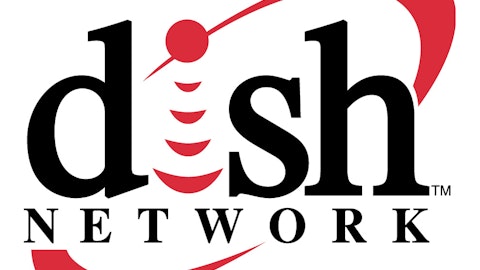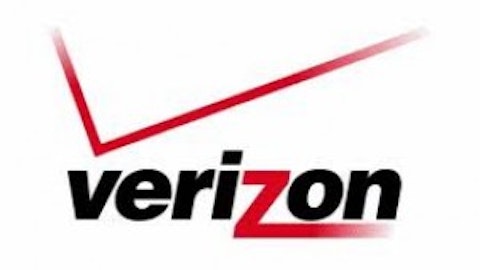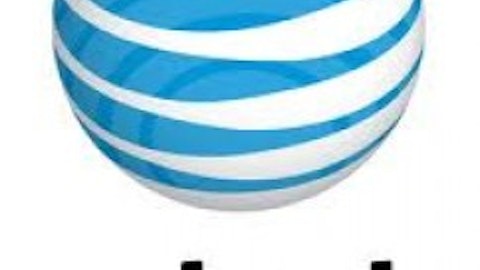Weaknesses - High valuation: Presently, the company carries a price to earnings ratio of 26.82, a price-to-book ratio of 2.17, and a price to sales ratio of 1.52; all of which indicate a company trading with a high valuation.
- Net debt: The company’s $6.8 billion in cash and cash equivalents is outweighed by its total liabilities of $117 billion, resulting in a net debt of roughly $110 billion, or $18.90 per share, a major financial weakness of the company.
Opportunities
- Increasing revenue per AT&T subscriber: Due to improvements in the caliber of service the company provides, the revenue AT&T Inc. (NYSE:T) derives from each mobile subscriber has increased from $12.0 per month in 2008 to $22.4 per month currently; with further growth in this metric projected, the company is presented the opportunity to fuel revenue growth.

- Gaining market share in mobile plans and phones: AT&T’s share in both the wholesale and postpaid industries has increased since 2008 (wholesale 2008: 3.28% currently: 5.14%) (postpaid 2008: 22.8% currently: 22.9%); any further gain in market share could fuel growth.


- Internet and TV segment: AT&T’s Internet and TV segment accounts for 16.01% of overall business and has been among the fastest growing in the overall company; the key metrics for this segment: TV pricing, TV subscribers, and Internet subscribers, all have been rapidly growing since 2008, and are projected to sustain this trend, presenting incredible potential growth.



- Dividend growth: Since implementing its dividend program in 1881, AT&T has consistently raised its dividend payouts and is widely expected to continue to do so well into the future.

- Continuation of growth in the wireless industry: The company’s wireless segment has been among the fastest growing since 2008, with revenue derived from the wireless data segment increasing from $10.6 billion in 2008 to $22.0 billion in 2011, and connected devices on its network increasing from 2.7 million in 2008 to 13.1 million in 2011; with further accelerated growth expected, AT&T is presented incredible opportunity to take advantage of this prospering industry.

Threats
- Constant need to update infrastructure: Just in 2011, AT&T poured $20.3 billion into upgrading its wireless and mobile broadband capabilities; this constant need to update infrastructure is expensive. With 4G LTE being offered by major competitors, major upgrades are inevitable.
Competitors








Major publicly traded competitors of AT&T include Verizon Communications Inc. (NYSE:VZ), Sprint Nextel Corporation (NYSE:S), T MOBILE US INC (NYSE:TMUS), and Comcast Corporation (NASDAQ:CMCSA). All of these companies are providers of wireless services with the exception of Comcast Corporation (NASDAQ:CMCSA), which provides Internet and TV services. All of these companies compete directly against AT&T.
Verizon Communications Inc. (NYSE:VZ) is valued at $141.01 billion, pays out a dividend yielding 4.18%, and carries a price-to-earnings ratio of 124.02. Verizon Communications Inc. (NYSE:VZ) possesses a price-to-book ratio of 4.40. Fundamentally, the company’s business model appears slightly profitable, with a TTM profit margin of 0.97%. Looking into the future, Verizon Communications Inc. (NYSE:VZ) is projected to experience mid-single digit growth in terms of revenue.
Sprint Nextel Corporation (NYSE:S) is valued at $20.76 billion, does not pay out a dividend, and carries a negative price-to-earnings ratio. Sprint possesses a price-to-book ratio of 3.11. Fundamentally, the company’s business model is flawed, with a TTM profit margin of -11.60%. Into the future, Sprint is not anticipated to achieve positive earnings until 2015.
T MOBILE US INC (NYSE:TMUS) is valued at $16.54 billion, does not pay out a dividend, and carries a price to earnings ratio of 10.40. T-Mobile recently acquired Metro PCS, and the resulting assets were spun into the current company offered today. Fundamentally, the company possesses a relatively strong business model with a TTM profit margin of 7.68%. Looking forward, T-Mobile is projected to carry low single-digit growth through 2017.
Comcast is valued at $104.94 billion, pays out a dividend yielding 1.96%, and carries a price-to-earnings ratio of 16.79. Comcast possesses a price-to-book ratio of 2.13. Fundamentally, the company’s business model is strong with a TTM profit margin of 10.18%. Into the future, Comcast is widely anticipated to sustain mid-single digit growth into 2017.
The Foolish Bottom Line:
Financially, AT&T is relatively solid with the exception of its substantial debt load. The company possesses solid revenue growth, a growing dividend, and possesses an established and diversified business model. The major weaknesses of the company include its debt load and high valuation. Looking forward, the company will draw fast-paced growth from the wireless industry and its U-Verse internet and TV segment. All in all, at current prices AT&T is neither a screaming buy or sell, however is a solid long-term investment which should hand investors steady returns for years to come.
The article Rethink Possible, Rethink Stable Investing originally appeared on Fool.com and is written by Ryan Guenette.
Ryan Guenette has no position in any stocks mentioned. The Motley Fool has no position in any of the stocks mentioned. Ryan is a member of The Motley Fool Blog Network — entries represent the personal opinion of the blogger and are not formally edited.
Copyright © 1995 – 2013 The Motley Fool, LLC. All rights reserved. The Motley Fool has a disclosure policy.




